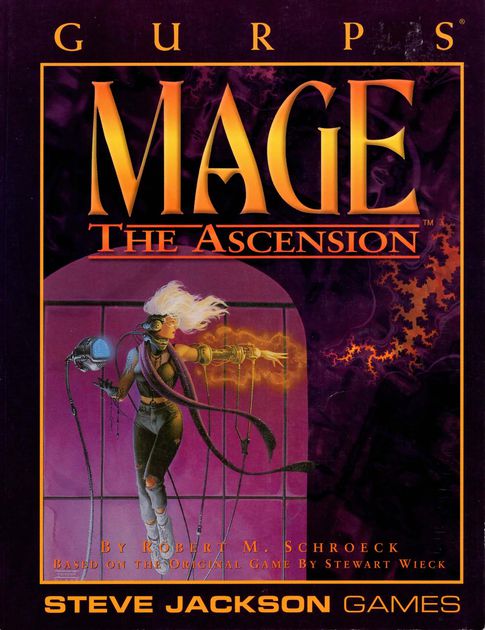
Mage: The Ascension is a flat out amazing game.
First Edition Mage was the second World of Darkness game I tried to run back in high school (Werewolf was the first) and it was gloriously broken. My players took full advantage of my lack of understanding to do intensely broken things but, while the ride felt wrong, it was still quite fun.
Over the next 20 years I drank deep of Mage and ran nearly every edition of The Ascension I could get my hands on. I even have the, frankly ancient, GURPS Mage: The Ascension book though I’ve never actually run nor played it.

It’s important to keep in mind that running a game of Mage can be a challenge. The setting and systems are built around the idea that reality is subjective and that your character is able to define what’s real. As a result, play can devolve into arguments about what your player characters can get away with.
At the same time you can have moments of high drama where the stakes of a conflict can rocket from street brawl to reality twisting madness at the drop of a few dice.
Most of the games I ran involved “street level” mages trying to navigate the interplay of sleepers (normal people) and willworkers (mages). Unlike the other World of Darkness PC types (vampires, werewolves, wraiths, and fae) Mages are still VERY mortal and look at the world through wide open human eyes. They don’t have a beast pushing them away from their humanity or a decidedly non-human side driving them away from their two legged cousins. They’re also not already dead nor are they possessed by an alien intelligence.
Additionally, thanks to paradox, Mages aren’t able to use their magick to solve every problem and have to keep one foot solidly in the mundane world. It’s this tension where the game, and the setting, really shines.
For additional context, here are a few criminally brief points about Mage as a setting:
- Reality as you know it is a lie. That’s not to say that reality isn’t real, because of course it is, but rather it’s more subjective than anyone’s comfortable admitting.
- The unconscious will of humanity defines and reinforces the reality people know. This is the dominant paradigm and you’ve lived in it your whole life.
- The dominant paradigm has changed and shifted many times as cultural norms rose and fell. In more superstitious epochs, spells, witchcraft, and faith were thought of as real and potent things. Magickal efforts that matched these expectations were easier to work and didn’t provoke the horror of paradox.
- Paradox is reality itself striking back at a mage for violating the dominant paradigm. It’s unclear of this is some kind of immune response or if there’s something behind the scenes of the universe that takes particular glee in punishing those who would try to break the rules.
- Sleepers, unawakened normal people, can’t directly influence the dominant paradigm but it’s theorized that if you can get critical mass of sleepers to all believe the same thing you can have a paradigm shift.
In Mage you play as a willworker who has awakened to the deeper structures of reality. Willworkers come in a near infinite variety of flavors but most break into two “camps” based on how they view their Magick.
- Traditions – Most player characters are Mages from one of the 9 Traditions. Each Tradition is generally associated with a style or approach to Magick which they foster and teach to their members. Rigorous hermetic ritual casters, Asian (east and south) influenced mystics, esoteric scientists, blood workers, faith workers, urban primitives, and Information Age Techno-fetishists are all found in the traditions.
- Technocratic Union – We live in a “rational” world full of modern technology and scientific progress. Technocrats won the war against superstition and managed to shape the Dominate Paradigm to their own ends, strengthening it even as they were constrained by it. The Union is made up of 5 Conventions based on approach and the area of reality they work to maintain.
The disparate Crafts, the incomprehensible Marauders, and the insidious Nephandi can also be found trying to bend reality in hidden corners of the world. More on them later.
Mages aren’t born able to bend reality but awaken to it. This process can be slow, like an apprentice or researcher putting the peaces together over decades, but most of the time, awakening happens suddenly, sometimes violently. In a flash the universe opens its cloak and the mage sees things as they truly are. Sometimes they go mad, sometimes they retreat and go back to sleep, but sometimes they manage to stay awake.
That bright moment then dims and what the mage is left with is a new perspective on the world and a connection to something beyond what they once knew. This is their Avatar, a spiritual self that can appear as nearly anything.
How connected a mage is to their avatar is generally referred to as their Arete (for Traditions) or Genius (for Technocrats). This “skill” can be increased with time and effort. The greater a mage’s Arete the more complicated their Magicks can be.
Magick is not a single thing and over the millennia mages have cataloged it’s near infinite forms and broken them down into 9 areas or Spheres.
- Correspondence -Space, distance, and the connections between things.
- Entropy – Luck, fate, and disorder.
- Forces – Fire, light, and energy in all its forms.
- Life – Living things, growth, and death.
- Matter – The physical structure of solid objects.
- Mind – Thoughts, ideas, and dreams.
- Prime – Creation energy, the animating force, and raw power.
- Spirit – Ephemera, the spirit world, and ghosts.
- Time – Slow down, speed up, and travel forward in time. There is no going back.
A mage’s knowledge of each sphere is further broken down into 5 levels that are generally understood as follows:
- Awareness/Perception
- Simple Manipulation
- Creation/Destruction/Control
- Advanced Manipulation/Command
- Mastery
Most workings don’t involve a single sphere and a mage often needs to combine them to get the effect they want. While Matter 3 could let a mage create a wall, it won’t last without Prime 2 to fill its pattern with base energy.
Why?
Why am I writing all this? Why does it matter?
It matters because I want to combine the stuff I love about Mage, the reality bending, the ideological warfare, and the struggle against Paradox with a game system that won’t get in the way.
So I’m converting Mage: The Ascension to Fate!
For those interested in digging into the mechanics of Mage that are being adapted to fate you can get a free Quickstart Guide to the Mage 20th Anniversary edition over at Drivethru RPG.

Basic Fate Mechanics
Mage: Powered by Fate uses Fate Core as it’s base with a few major hacks.
If you’re interested in some of the basics of Fate there’s a decent amount of free information and a fairly understandable primer over at the Fate Core Basics SRD.
New Skill: Arete/Genius
Arete is used by Willworkers to bend reality into whatever the Mage has in mind, assuming they have enough knowledge and awareness to understand what needs to be pushed, pulled, or tugged. Arete can be used to Attack, Overcome, and Create Advantage but how this is done is based on whatever Spheres the Mage has access to. Arete can only be used as a Defence against an Arete attack and only if the defending mage has at least 1 rank in the highest level Sphere being used in that attack.
Extra: Spheres
Characters start with 6 ranks in spheres and can have no sphere higher than rank 3 without additional Stunts. One sphere must be the Mage’s speciality sphere (based on their Tradition/Convention). More ranks in spheres can be purchased with Stunts/Refresh at a rate of 2 ranks for 1 stunt. Raising a sphere to rank 4 or higher costs 1 Stunt/Refresh per rank.
Difficulty
The difficulty for any magickal effect is equal to double the highest sphere used in the effect (+2 to +10). Higher ranked magic generally requires the expenditure of Fate points and the liberal use of Created Advantages. Conjuring decimating effects on the fly is difficult but can be done with sufficient skill and power.
Extra: Foci
A mage cannot just will it and have reality bend accordingly. They need to use rituals, tools, and procedures based on their tradition/convention to make their Magick work. A mage will generally have one category of foci per sphere and they need to use multiple foci if they are trying to pull off an effect that has multiple spheres.
Optional: Tradition Mages, being used to fighting against the dominant paradigm, may spend a fate point to ignore one category of foci while casting.
Extra: Paradox
Each time a Mage bends reality they run the risk of reality taking it personal. This paradox backlash could be as mild as bad case of warts as as devastating as a reversed digestive tract. In extreme cases a Mage may slip into Quiet or a Paradox Spirit may come calling. Quiet and Spirits are what happens when a Mage is Taken Out via paradox.
Paradox is always a risk but it increased depending on and effect’s vulgarity (how much if violates the dominant paradigm) and if there are any sleeper witnesses. A “risk free” way of using magick is to cast spells coincidentally, but this works by setting magick loose into the world and waiting for things to manifest in a more believable form. Multiple uses of coincidental magick can still trigger a paradox backlash as a kind of domino effect. One exploded steam pipe is believable, 3 in 5 minutes is less so.
Paradox Stress Track
When a Paradox Backlash happens the Mage takes shifts of harm to their paradox stress track based on the effect’s vulgarity. There is no defence roll to reduce these shifts.
- Coincidental: No shifts OR shifts equal to the highest sphere used if the same coincidental effect is used more than once in the same conflict.
- Vulgar without Witnesses: Shifts equal to highest sphere used.
- Vulgar with Witnesses: Shifts equal to double the highest sphere used.
A Mage’s connection to their avatar not only lets them work magick but also lets them absorb a certain amount of backlash without long term negative effects.
All mages have a new Paradox Stress Track in addition to their physical and mental stress tracks. This track starts with [1][2] stress boxes and can only absorb shifts from paradox backlashes.
This track is increased by a Mage’s Arete skill with +1-+2 granting [1][2][3], Arete skill +3-4 granting [1][2][3][4], and an Arete skill of +5 or more granting [1][2][3][4] and an additional mild consequence slot just for paradox flaws. Magick cannot be used to reduce shifts from a paradox backlash.
Paradox Flaws
Any left over shifts of harm from Paradox create a special kind of Consequence called a Paradox Flaw. These flaws work exactly like any other consequence, they take up the character’s existing consequence slots, and can only be removed/recovered with time. Magick, or any other form of supernatural healing, cannot be used to remove a Paradox Flaw or speed up a Flaw’s recovery. Reality can be a harsh mistress.
Further Reading:
I’m not the first to try to convert Mage to Fate, big ups to these other folks for breaking the ground and helping to guide my choices in the project.
- https://douglasunderhill.wordpress.com/2017/04/07/mage-core-mage-the-ascension-in-fate-core/
- http://ryanmacklin.com/2013/07/mage-the-coreing/
- https://forum.rpg.net/showthread.php?676879-Fate-Core-Mage-the-Ascension-The-Awakening-Magics-system-conversions
- http://walkingmind.evilhat.com/2013/06/12/approaches-as-and-add-on/
That’s it for this entry but stay tuned for future articles that should drill deeper into the glory of Mage and Fate!

This post is great as a primer just for Mage. Adding in the Fate mechanics is bonus!
LikeLike
Thanks for the proverbial shout 🙂
LikeLike
I am long time lover of both these systems, and I am so glad you took the time to sit down and do the work to help create a way to keep the best aspects of both.
LikeLike
[…] the basics in place let’s talk about making a Mage […]
LikeLike
Do you have ideas on this in FAE?
LikeLike
Hey brother!
I just want to thank you for this great work!
LikeLiked by 1 person